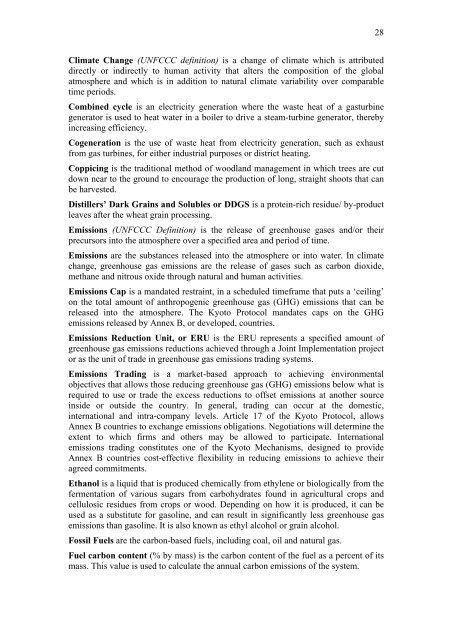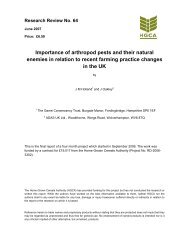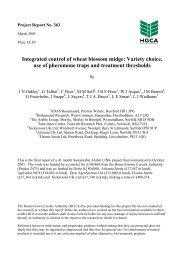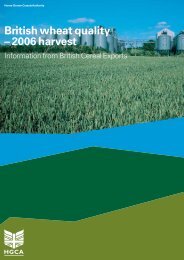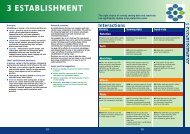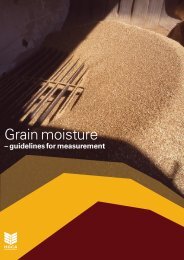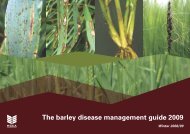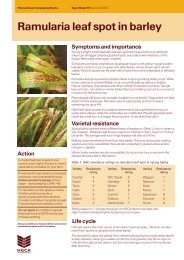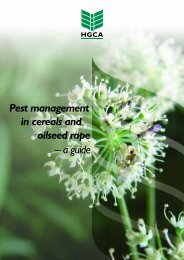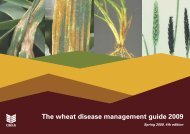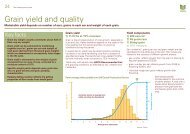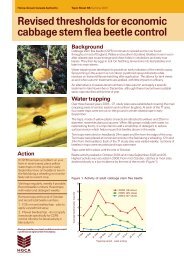BIOETHANOL GREENHOUSE GAS CALCULATOR - HGCA
BIOETHANOL GREENHOUSE GAS CALCULATOR - HGCA
BIOETHANOL GREENHOUSE GAS CALCULATOR - HGCA
Create successful ePaper yourself
Turn your PDF publications into a flip-book with our unique Google optimized e-Paper software.
28Climate Change (UNFCCC definition) is a change of climate which is attributeddirectly or indirectly to human activity that alters the composition of the globalatmosphere and which is in addition to natural climate variability over comparabletime periods.Combined cycle is an electricity generation where the waste heat of a gasturbinegenerator is used to heat water in a boiler to drive a steam-turbine generator, therebyincreasing efficiency.Cogeneration is the use of waste heat from electricity generation, such as exhaustfrom gas turbines, for either industrial purposes or district heating.Coppicing is the traditional method of woodland management in which trees are cutdown near to the ground to encourage the production of long, straight shoots that canbe harvested.Distillers’ Dark Grains and Solubles or DDGS is a protein-rich residue/ by-productleaves after the wheat grain processing.Emissions (UNFCCC Definition) is the release of greenhouse gases and/or theirprecursors into the atmosphere over a specified area and period of time.Emissions are the substances released into the atmosphere or into water. In climatechange, greenhouse gas emissions are the release of gases such as carbon dioxide,methane and nitrous oxide through natural and human activities.Emissions Cap is a mandated restraint, in a scheduled timeframe that puts a ‘ceiling’on the total amount of anthropogenic greenhouse gas (GHG) emissions that can bereleased into the atmosphere. The Kyoto Protocol mandates caps on the GHGemissions released by Annex B, or developed, countries.Emissions Reduction Unit, or ERU is the ERU represents a specified amount ofgreenhouse gas emissions reductions achieved through a Joint Implementation projector as the unit of trade in greenhouse gas emissions trading systems.Emissions Trading is a market-based approach to achieving environmentalobjectives that allows those reducing greenhouse gas (GHG) emissions below what isrequired to use or trade the excess reductions to offset emissions at another sourceinside or outside the country. In general, trading can occur at the domestic,international and intra-company levels. Article 17 of the Kyoto Protocol, allowsAnnex B countries to exchange emissions obligations. Negotiations will determine theextent to which firms and others may be allowed to participate. Internationalemissions trading constitutes one of the Kyoto Mechanisms, designed to provideAnnex B countries cost-effective flexibility in reducing emissions to achieve theiragreed commitments.Ethanol is a liquid that is produced chemically from ethylene or biologically from thefermentation of various sugars from carbohydrates found in agricultural crops andcellulosic residues from crops or wood. Depending on how it is produced, it can beused as a substitute for gasoline, and can result in significantly less greenhouse gasemissions than gasoline. It is also known as ethyl alcohol or grain alcohol.Fossil Fuels are the carbon-based fuels, including coal, oil and natural gas.Fuel carbon content (% by mass) is the carbon content of the fuel as a percent of itsmass. This value is used to calculate the annual carbon emissions of the system.


